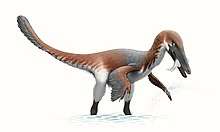Pectinodon
Pectinodon is a genus of bird like dinosaurs from the Late Cretaceous period (66 mya). It currently contains a single valid species, Pectinodon bakkeri (sometimes classified as Troodon bakkeri), known only from teeth.[1]
| Pectinodon | |
|---|---|
 | |
| Tooth of cf. Pectinodon | |
| Scientific classification | |
| Kingdom: | Animalia |
| Phylum: | Chordata |
| Clade: | Dinosauria |
| Clade: | Saurischia |
| Clade: | Theropoda |
| Family: | †Troodontidae |
| Genus: | †Pectinodon Carpenter, 1982 |
| Type species | |
| †Pectinodon bakkeri Carpenter, 1982 | |
| Synonyms | |
| |
In 1982, Kenneth Carpenter named a number of theropod teeth from the late Maastrichtian Lance Formation of Wyoming as the type species Pectinodon bakkeri. The generic name is derived from Latin pecten, "comb", and Greek ὀδών, odon, "tooth", in reference to the comb-like serrations on the rear edge of the teeth. The specific name honours Robert Thomas Bakker.[1]
History of discovery

The holotype, UCM 38445, consists of a 6.2 mm long adult tooth. The paratypes are three juvenile teeth.[1]
In 1985 Lev Nesov named a second species, Pectinodon asiamericanus, based on specimen CCMGE 49/12176, a tooth from the Khodzhakul Formation of Uzbekistan dating from the Cenomanian.[2] This is today often considered a nomen dubium.[3]
While historically considered synonymous with Troodon or more specifically the species Troodon formosus, Philip Currie and colleagues (1990) noted that the P. bakkeri fossils from the Hell Creek Formation and Lance Formation might belong to different species. In 1991, George Olshevsky assigned the Lance formation fossils to the species Troodon bakkeri.[4][5] In 2011, Zanno and colleagues reviewed the convoluted history of troodontid classification in Late Cretaceous North America. They followed Longrich (2008) in treating Pectinodon bakkeri as a valid genus,[6] and noted that it is likely the numerous Late Cretaceous specimens currently assigned to Troodon formosus almost certainly represent numerous new species, but that a more thorough review of the specimens is required.[7]
In 2013 Currie and Derek Larson concluded that Pectinodon bakkeri was valid and its teeth could be found both in the Lance Formation and the coeval Hell Creek Formation. Some teeth from the older Campanian Dinosaur Park Formation could not be statistically differentiated from them, likely due to an insufficiently large sample, and were referred to a cf. Pectinodon.[8]
See also
References
- Carpenter, K. (1982). "Baby dinosaurs from the Late Cretaceous Lance and Hell Creek formations and a description of a new species of theropod" (PDF). Contributions to Geology, University of Wyoming. 20 (2): 123–134.
- L.A. Nesov, 1985, "Novye mlekopitayushchie Mela Kyzylkumov", Vestnik Leningradskogo Universiteta, Geologiia, Geografiia, series 7 17: 8-18
- A. O. Averianov and H.-D. Sues, 2007, "A new troodontid (Dinosauria: Theropoda) from the Cenomanian of Uzbekistan, with a review of troodontid records from the territories of the former Soviet Union", Journal of Vertebrate Paleontology 27(1): 87-98
- Olshevsky, G., 1991 A Revision of the Parainfraclass Archosauria Cope, 1869, Excluding the Advanced Crocodylia. Mesozoic Meanderings 2 196 pp
- Currie, P. (2005). "Theropods, including birds." in Currie and Koppelhus (eds). Dinosaur Provincial Park, a spectacular ecosystem revealed, Part Two, Flora and Fauna from the park. Indiana University Press, Bloomington. Pp 367–397.
- N. Longrich, 2008, "A new, large ornithomimid from the Cretaceous Dinosaur Park Formation of Alberta, Canada: implications for the study of dissociated dinosaur remains", Palaeontology 51(4) 983-997
- Lindsay E. Zanno; David J. Varricchio; Patrick M. O'Connor; Alan L. Titus; Michael J. Knell (2011). "A new troodontid theropod, Talos sampsoni gen. et sp. nov., from the Upper Cretaceous Western Interior Basin of North America". PLoS ONE. 6 (9): e24487. doi:10.1371/journal.pone.0024487. PMC 3176273. PMID 21949721.
- Larson D.W., Currie P.J., 2013, "Multivariate Analyses of Small Theropod Dinosaur Teeth and Implications for Paleoecological Turnover through Time", PLoS ONE 8(1): e54329. doi:10.1371/journal.pone.0054329



.png)





.png)


